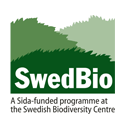Click on images to enlarge
/thumbs/mimosa_pudica1_-_SH_sml.jpg)
close-up of seeds (Photo: Steve Hurst at USDA PLANTS Database)
/thumbs/mimosa_pudica4_-_FKS_sml.jpg)
close-up of flower cluster and flower buds showing the prominent pink stamens (Photo: Forest and Kim Starr, USGS)
/thumbs/mimosa_pudica_hispida5_sml.jpg)
seedling (Photo: Sheldon Navie)
/thumbs/mimosa_pudica_unijuga8_sml.jpg)
the sparsely hairy stems and leaves of Mimosa pudica var. unijuja (Photo: Sheldon Navie)
/thumbs/mimosa_pudica_unijuga16_sml.jpg)
close-up of immature fruit (Photo: Sheldon Navie)
Scientific name
Mimosa pudicaL.
Synonyms
Mimosa hispidula Kunth
Common names
Sensitive plant, touch-me-not plant, humble plant, shameful plant (English)
Family
Fabaceae (Leguminosae): sub-family Mimosoideae
Origin
This species originated in tropical Central and South America.
Naturalised distribution (global)
Mimosa pudica is naturalised throughout the tropics.
Introduced, naturalised or invasive in East Africa
Mimosa pudica is invasive in Kenya (A.B.R. Witt pers. obs.), Tanzania (Tropical Biology Association 2010) and Uganda (A.B.R. Witt pers. obs.).
Habitat
A weed of wetter coastal areas. It is mostly found in plantation crops, disturbed sites, pastures, waste areas, parks, lawns, gardens and along roadsides.
Description
A prickly, long-lived (perennial), herbaceous plant or small shrub with a creeping (prostrate or decumbent) or sprawling habit. It usually only grows 15-50 cm tall, but can reach up to 1 m or more in height when supported by other vegetation.
Mimosa pudica is not the only member of the legume plant family (Leguminosae) to move in response to stimuli. More species of Mimosa show sensitivity to touch, known as seismonasty. Other legumes, for example some members of the genera Neptunia, Acacia, Albizia and Samanea, respond to a lesser degree by showing 'sleep movements' (nyctinasty) in their natural habitats (Barneby 1991). This involves the closing up of the leaves a few hours before dusk, and the re-opening of the leaves a few hours before dawn. It is thought that these 'sleep movements' aid water conservation as well as defence against herbivory.
Sensitive plant is an annual or long-lived (perennial) that normally grows to 50-70 cm tall (but can be up to 1 m tall), and often takes the form of a straggling prickly sub-shrub (Burkill 1995). Its stems have sparse prickles, 2-2.5 mm long, or are sometimes bristly, or can also be almost hairless. The leaves are alternate, twice-compound (bipinnate), do not have prickles and are very sensitive to touch. The rachis (axis of the compound leaf) is 1.5-5.5 cm long, and the pinnae (primary divisions of the compound leaf) are subdigitate (almost finger-like projections). There are 10-26 pairs of leaflets (the smallest segments of the leaf) per pinna, which are 6-15 x 1.2-3 mm and linear-oblong.
The flowers are lilac or pink (the colour mainly the stamen filaments) and are held in ovoid, stalked heads of 1-1.3 x 0.6-1 cm. A cluster of 1-5 flower-heads is borne in the leaf axil. The calyx is minute, about 0.2 mm long. The corolla is 2-2.3 mm long, and contains four stamens. The pods are 1.8 cm x 3-5 mm, densely bristly, clustered, and have prickles along their margins.
Reproduction and dispersal
This plant reproduces by seeds. Each plant can produce over 700 bristled seeds which can be carried on animal fur, feathers or on people's clothing.
Similar species
Mimosa pudica is similar to Mimosa pigra (giant sensitive plant) and creeping sensitive plant (Mimosa diplotricha var. diplotricha), which both also produce pink globular flower clusters and have prickles. These species can be distinguished by the following differences:
- M. pudica is a relatively small plant, with a somewhat spreading (prostrate) habit, that has few-branched leaves (with one or two pairs of branchlets). It produces relatively small pods (1- 2.5 cm long) that contain only 1-6 one-seeded segments.
- M. pigra is a large shrub with an upright (erect) growth habit that has large much-branched leaves (with 6-16 pairs of branchlets). It produces relatively large pods (3-8 cm long) that contain 14-26 one-seeded segments.
- M. diplotricha var. diplotricha is an upright (erect) shrub or climbing plant that has much-branched leaves (with 4-9 pairs of branchlets). It produces relatively small pods (1-3.5 cm long) that contain only 3-5 one-seeded segments.
Economic and other uses
Mimosa pudica is popular as a house plant. It has been planted as a cover crop and for erosion control.
Environmental and other impacts
Mimosa pudica is a serious weed of crops and pastures throughout the tropics. It can also increase the incidence of fires. M. pudica has been included in the Global Invasive Species Database (GISD 2010). It has been listed as a noxious weed in the Northern Territories Australia.
Management
The precise management measures adopted for any plant invasion will depend upon factors such as the terrain, the cost and availability of labour, the severity of the infestation and the presence of other invasive species. Some components of an integrated management approach are introduced below.
The best form of invasive species management is prevention. If prevention is no longer possible, it is best to treat the weed infestations when they are small to prevent them from establishing (early detection and rapid response). Controlling the weed before it seeds will reduce future problems. Control is generally best applied to the least infested areas before dense infestations are tackled. Consistent follow-up work is required for sustainable management.
Hand weeding of older plants is difficult because the plant's prickles can break off and irritate the skin. Hoeing can be used to remove the plant. Sensitive plant can be controlled by manipulating grazing regimes but over or under-grazing can encourage its spread and grazing animals can spread its seed. Herbicides such as foliar sprays of glyphosate are widely used to control the species. When using any herbicide always read the label first and follow all instructions and safety requirements. If in doubt consult an expert. Fire can be used as a management tool, but usually in combination with other methods such as chaining. Fire alone may actually increase M. pudica densities by plant regrowth and enhanced seed germination.
Although no work has been undertaken on the biological control of sensitive plant there is potential in view of the success of biological control programmes against the related Mimosa invisa.
Legislation
Not listed as a noxious weed by the state or governments in Kenya, Tanzania and Uganda.
References
CABI Invasive Species Compendium online data sheet. Mimosa pudica (sensitive plant). CABI Publishing 2011. www.cabi.org/ISC. Accessed March 2011.
GISD (2010). Global Invasive Species Database online data sheet. Mimosa pudica (herb). www.issg.org/database. Accessed March 2011.
Tropical Biology Association (2010). Usambara Invasive Plants - Amani Nature Reserve - www.tropical-biology.org/research/dip/species.htm.
Editors
Agnes Lusweti, National Museums of Kenya; Emily Wabuyele, National Museums of Kenya, Paul Ssegawa, Makerere University; John Mauremootoo, BioNET-INTERNATIONAL Secretariat - UK.
Acknowledgments
This fact sheet is adapted from The Environmental Weeds of Australia by Sheldon Navie and Steve Adkins, Centre for Biological Information Technology, University of Queensland. We recognise the support from the National Museums of Kenya, Tropical Pesticides Research Institute (TPRI) - Tanzania and Makerere University, Uganda. This activity was undertaken as part of the BioNET-EAFRINET UVIMA Project (Taxonomy for Development in East Africa).
Contact
BioNET-EAFRINET Regional Coordinator: [email protected]












